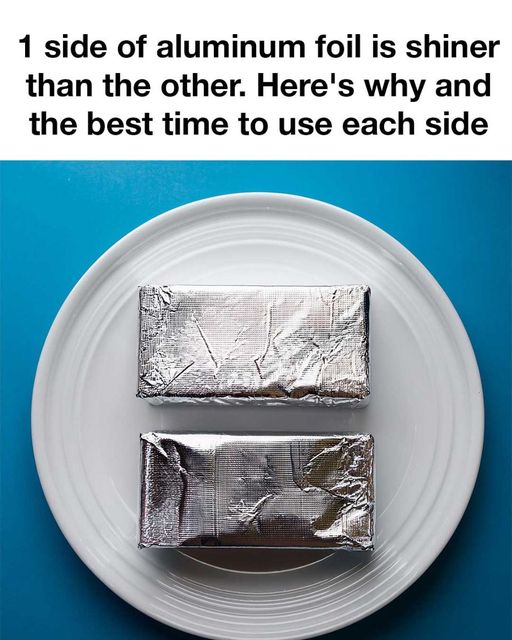Aluminum foil is a staple in many kitchens across the globe, celebrated for its versatility in cooking, baking, and even for various household tasks. Yet, you might have noticed something curious about this everyday kitchen item: one side shines more brightly than the other. Have you ever wondered why this is the case, or if one side is better than the other for certain jobs? You’re not alone! This little detail has sparked plenty of conversations and speculations over time.

Join us as we explore why aluminum foil looks this way, delve into the science of its production, and clarify what each side is best used for.
Understanding How Aluminum Foil is Made
The secret of the differing sides of aluminum foil lies in its manufacturing process. Initially, aluminum foil is crafted by rolling thick slabs of aluminum into thinner sheets. This involves several rounds of rolling, heating, and cooling. In the final roll, two layers are pressed together and then separated, a step called ‘tandem rolling’. This approach stops the foil from tearing. The side in contact with the rollers emerges shinier, polished by the steel, while the side away from the rollers has a matte finish.
Shiny vs. Dull: What Causes the Difference?
The differing shine of aluminum foil sides is purely a result of how it’s made, specifically during the final rolling action. The side facing the rollers gets a smooth, gleaming surface, while the opposite side stays matte, looking less reflective. This has led to many theories on whether one side outperforms the other, although the differences are largely cosmetic.
Is There a Functional Difference Between the Sides?
Contrary to some beliefs, there is no essential difference in how the shiny and dull sides function. Both sides are equally effective at blocking moisture, light, and air. However, the shiny side can reflect heat slightly better, which might be beneficial in some cooking scenarios. However, this is a minor difference, so for most uses, the choice of side is mostly about personal preference.
When to Use the Shiny Side
The reflective quality of the shiny side of aluminum foil can help in retaining heat, useful if you want your food to stay warm for a longer time. For instance, wrapping food with the shiny side facing outwards can be advantageous for heat retention. It can also be used to reflect heat upwards, beneficial for grilling or broiling. Nevertheless, the difference in heat reflectivity is slight and won’t greatly alter cooking results.
The Practical Use of the Dull Side
Even with lower reflectivity, the dull side of aluminum foil is just as fit for all tasks. It comes in handy if you’re trying to reduce glare in a bright kitchen or prefer a less shiny appearance. When dealing with foods that might adhere to the foil, some prefer the dull side, though both sides function the same. The dull side’s surface is excellent for writing labels or notes directly on it.
Busting Myths and Misconceptions
A popular myth suggests the dull side is for storing, while cooking should always be done with the shiny side facing inwards to reflect heat. However, science debunks these views, indicating both sides perform similarly. Cook as you wish—the primary variance is in look, not in function. Many cooking fans fall for these myths, leading to needless bewilderment.
Expert Insight and Scientific Perspective
Research and expert views reveal that the difference in heat reflectivity between the two foil sides is minimal, often less than 10%. Culinary experts and chefs typically note that choosing which side to use is more about ease and habit rather than any technical advantage. Materials science authorities clarify that the double-sided nature comes from the manufacturing process with little practical consequence for most purposes.
Handy Tips for Everyday Use
For daily tasks, consider these tips: opt for the shiny side if you’re aiming to insulate or retain heat, albeit the effect is minor; go for the dull side to avoid reflections; it’s great for labeling purposes; and when unsure, remember that either side will work effectively for nearly all situations, be it grilling, wrapping, or baking.
Wrapping Up
In summary, the shininess of one side of aluminum foil over the other comes from its creation process. Any small differences in heat reflection don’t significantly impact most kitchen uses. Ultimately, whether you go with the shiny or dull side often boils down to personal habit or particular needs. Understanding this can streamline your kitchen activities and help dispel any myths about aluminum foil.